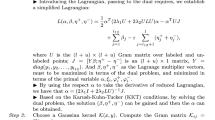Abstract
Semi-supervised learning has attracted researchers due to its advantages over supervised learning. In this paper, an extremely fast multi-category classification algorithm, termed as weighted ternary decision structure (WTDS) is proposed. WTDS is a generic algorithm that can extend any binary classifier into multi-category framework. This work also proposes a novel semi-supervised binary classifier termed as Weighted Laplacian least-squares twin support vector machine which is further extended using WTDS. The novel semi-supervised classifier obtains the solution by formulating a pair of Unconstrained Minimization Problems which are solved as systems of linear equation. WTDS takes advantage of the strengths of the classifier and efficiently constructs the multi-category classifier model in the form of a decision structure. WTDS outperforms other state-of-the-art multi-category approaches in terms of classification accuracy and time complexity. To confirm the feasibility and efficacy of proposed algorithm, experiments are conducted on benchmark UCI datasets.





Similar content being viewed by others
Notes
The bold figures indicate best value for the given dataset.
References
Belkin M, Niyogi P, Sindhwani V (2006) Manifold regularization: a geometric framework for learning from labeled and unlabeled examples. J Mach Learn Res 7:2399–2434
Blake C, Merz CJ (1998) Uci repository of machine learning databases. UCI Repository http://www.ics.uci.edu/~mlearn/MLRepository.html
Chapelle O, Schölkopf B, Zien A (2006) Semi-supervised learning. MIT Press, Cambridge
Chen WJ, Shao YH, Deng NY, Feng ZL (2014) Laplacian least squares twin support vector machine for semi-supervised classification. Neurocomputing 145:465–476
Cormen TH (2009) Introduction to algorithms. MIT Press, Cambridge
Culp M, Michailidis G (2008) Graph-based semisupervised learning. IEEE Trans Pattern Anal Mach Intell 30(1):174–179
Duda RO, Hart PE, Stork DG (2012) Pattern classification. Wiley, New York
Fookes C, Denman S, Lakemond R, Ryan D, Sridharan S, Piccardi M (2010) Semi-supervised intelligent surveillance system for secure environments. In: IEEE international symposium on industrial electronics (ISIE), 2010, pp 2815–2820
Geng C, Yuquan Z, Jianing T, Tianhan H (2009) An algorithm of semi-supervised web-page classification based on fuzzy clustering. In: International forum on information technology and applications, 2009. IFITA’09. IEEE, vol 1, pp 3–7
Hsu CW, Lin CJ (2002) A comparison of methods for multiclass support vector machines. IEEE Trans Neural Netw 13(2):415–425
Hsu CW, Chang CC, Lin CJ, et al. (2003) A practical guide to support vector classification
Jain AK (2010) Data clustering: 50 years beyond k-means. Pattern Recogn Lett 31(8):651–666
Jayadeva Khemchandani R, Chandra S (2007) Twin support vector machines for pattern classification. IEEE Trans Pattern Anal Mach Intell 29(5):905–910
Jin G, Raich R, Miller DJ (2013) A generative semi-supervised model for multi-view learning when some views are label-free. In: 2013 IEEE international conference on acoustics, speech and signal processing, IEEE, pp 3302–3306
Joachims T et al (2003) Transductive learning via spectral graph partitioning. ICML 3:290–297
Khemchandani R, Pal A (2016) Multi-category laplacian least squares twin support vector machine. Appl Intell 45(2):458–474
Khemchandani R, Saigal P (2015) Color image classification and retrieval through ternary decision structure based multi-category twsvm. Neurocomputing 165:444–455
Khemchandani R, Saigal P, Chandra S (2016) Improvements on \(\nu \)-twin support vector machine. Neural Netw 79:97–107
Khemchandani R, Saigal P, Chandra S (2018) Angle-based twin support vector machine. Ann Oper Res 269(1–2):387–417
Kumar MA, Gopal M (2009) Least squares twin support vector machines for pattern classification. Expert Syst Appl 36(4):7535–7543
Li J, Bioucas-Dias JM, Plaza A (2012) Semisupervised hyperspectral image classification using soft sparse multinomial logistic regression. IEEE Geosci Remote Sens Lett 10(2):318–322
Lu S, Wang H, Zhou Z (2019) All-in-one multicategory ramp loss maximum margin of twin spheres support vector machine. Appl Intell, pp 1–14
Nasiri JA, Charkari NM, Jalili S (2015) Least squares twin multi-class classification support vector machine. Pattern Recogn 48(3):984–992
Qi Z, Tian Y, Shi Y (2012) Laplacian twin support vector machine for semi-supervised classification. Neural Netw 35:46–53
Rastogi R, Saigal P, Chandra S (2018a) Angle-based twin parametric-margin support vector machine for pattern classification. Knowl-Based Syst 139:64–77
Rastogi R, Sweta S, Chandra S (2018b) Robust parametric twin support vector machine for pattern classification. Neural Process Lett 47(1):293–323
Saigal P, Khemchandani R (2015) Nonparallel hyperplane classifiers for multi-category classification. In: IEEE workshop on computational intelligence: theories, applications and future directions (WCI), 2015, IEEE, pp 1–6
Saigal P, Khanna V, Rastogi R (2017) Divide and conquer approach for semi-supervised multi-category classification through localized kernel spectral clustering. Neurocomputing 238:296–306
Saigal P, Chandra S, Rastogi R (2019) Multi-category ternion support vector machine. Eng Appl Artif Intell 85:229–242
Soares RG, Chen H, Yao X (2012) Semisupervised classification with cluster regularization. IEEE Trans Neural Netw Learn Syst 23(11):1779–1792
Sun Z, Wang C, Li D, Li J (2014) Semisupervised classification for hyperspectral imagery with transductive multiple-kernel learning. IEEE Geosci Remote Sens Lett 11(11):1991–1995
Tur G, Hakkani-Tür D, Schapire RE (2005) Combining active and semi-supervised learning for spoken language understanding. Speech Commun 45(2):171–186
Vapnik V (2013) The nature of statistical learning theory. Springer, Berlin
Ye M, Stankovic V, Stankovic L, Cheung G (2019) Deep graph regularized learning for binary classification. In: ICASSP 2019-IEEE international conference on acoustics, speech and signal processing (ICASSP), IEEE, pp 3537–3541
Zhang X, Song Q, Liu R, Wang W, Jiao L (2014) Modified co-training with spectral and spatial views for semisupervised hyperspectral image classification. IEEE J Sel Top Appl Earth Observ Remote Sensing 7(6):2044–2055
Author information
Authors and Affiliations
Corresponding author
Additional information
Publisher's Note
Springer Nature remains neutral with regard to jurisdictional claims in published maps and institutional affiliations.
Rights and permissions
About this article
Cite this article
Saigal, P., Rastogi, R. & Chandra, S. Semi-supervised Weighted Ternary Decision Structure for Multi-category Classification. Neural Process Lett 52, 1555–1582 (2020). https://doi.org/10.1007/s11063-020-10323-7
Published:
Issue Date:
DOI: https://doi.org/10.1007/s11063-020-10323-7




